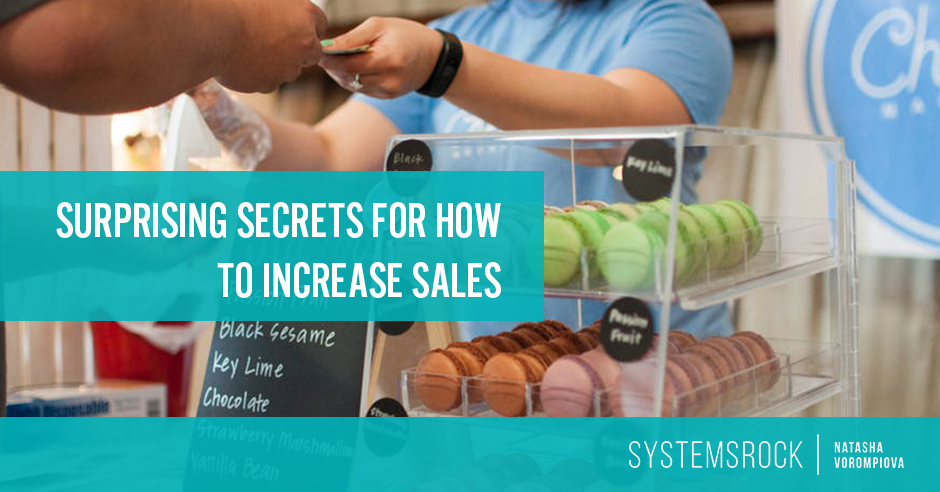I’m exploding a myth about how to increase sales.
All that time you’re spending learning sales techniques, rehearsing what you’re going to say during sales conversations and tweaking elevator pitches isn’t going to help you get better at selling.
Want to increase sales? All you have to do is learn to listen more carefully.
Look, I’ll be honest. I used to hate sales conversations.
I’d get flushed, sweat profusely and speak inaudibly. Then, I’d majorly undercharge for my services because it seemed the people with whom I was speaking couldn’t afford them.
Part of the problem was that I was trying to sell to less-than-ideal clients.
But not listening attentively enough to my ideal prospective clients was also playing a major role in my inability to increase sales.
You don’t have to go through what I went through!
4 Secret Ingredients for Increasing Sales
After I realized what was going on, I spent a great deal of time creating the right recipes for more successful sales conversations and then systematizing the underlying process.
The fact of the matter is that there’s no one-size-fits-all formula for selling.
Selling is a lot like cooking.
You’ve got to have the necessary ingredients and be willing to adapt them to the needs—the appetites—of your potential clients.
I’m sharing these key ingredients so you can increase your sales—the easy way!
1. Listen Closely
You know the benefits clients get when teaming up with you, but to tip sales conversations in your favor, make sure you listen carefully to how prospects describe their needs and goals. Use their language when describing how you can satisfy these needs and achieve their objectives.
For instance, if you’re a copywriter, listen to how potential clients explain why they need help creating their sales pages. Then, when you’re closing the sale, incorporate some of these keywords into your description of your services.
The great thing about this approach is that you don’t have to rely on formulaic scripts that make everyone feel awkward.
The conversation will flow—and your services will sound even more appealing—because you’re helping potential clients feel aligned with you and your expertise.
2. Demonstrate Value
One of the easiest ways to get people to say “yes” is to demonstrate how the value you create for them exceeds the cost of your services.
My best advice?
Focus on providing a solution—on being of service—instead of on selling yourself and your products.
Showing prospective clients how working with you helps them meet important business objectives makes it much easier for them to say “yes.”
Unfortunately, clients aren’t always clear what problems they want to be solved or what their objectives are. Your job is to help them get this clarity and understand the benefits of resolving these challenges and meeting these goals.
Only when you start asking questions and listening for bigger goals and objectives, can you see the bigger picture and demonstrate the value of your contribution.
Let’s say that a potential client told you that she wants to generate $10,000 from an online course and needs you to write a sales page for it.
Snap up this new customer by helping her see how investing just $1,000 in your copywriting services can quickly help her achieve this goal.
Have stats from previous clients? Share them!
3. Establish Trust
Listening also builds the trust necessary for closing sales.
Before they see you in action delivering the results you promised, all that new prospects have to rely on is your word. They buy your confidence and certainty that you are the one person who can help them.
To demonstrate your expertise, ask insightful questions.
Good questions make prospects feel that you know what you are talking about, show you’re interested in understanding their unique problems, and reveal your ability to design solutions to these exact challenges.
Listen attentively to the answers prospects give you and make perceptive observations to build trust and reassure them you are the one they need.
Share relevant client success stories to provide social proof of your expertise.
If, for example, a prospect tells you that brand consistency is important to her, show her how you will ensure that the language on the sales page is consistent with the language of the entire site. Then, give an example of a former client who couldn’t tell the difference between the pieces she had written herself and the ones you created.
4. Tap Into Your Desire to Serve
Before entering into any sales conversation, allow yourself to make a subtle shift from selling to service.
Going into the situation with the desire to serve your prospects allows you to express more compassion about the challenges they’re facing, opens you up to listening even more attentively to their needs, helps you explain your services and benefits in terms of what’s most valuable to them and makes it easier to recommend approaches that will help them quickly reach their goals.
Maybe you can create 2 versions of the sales page, so the client can do a split test to see which page converts better. Perhaps you can recommend that she format testimonials in such a way that they address every possible objection and minimize the number of questions people will have. Once the content is approved, you could even suggest that you collaborate with the web person to work on the layout of the sales page and thus save the client time.
As you can see, listening can turn any service or product recipe into an irresistible signature dish on your menu.
BACK TO YOU
Are your sales conversations missing any of the above ingredients? What’s your biggest challenge?


